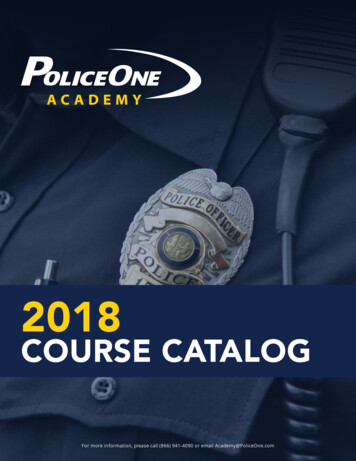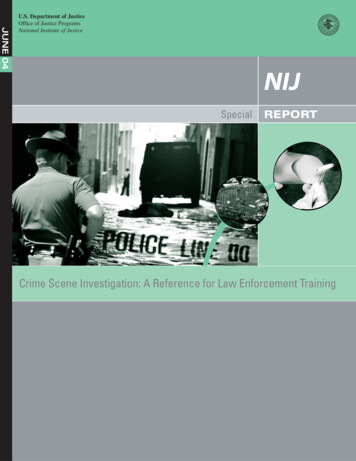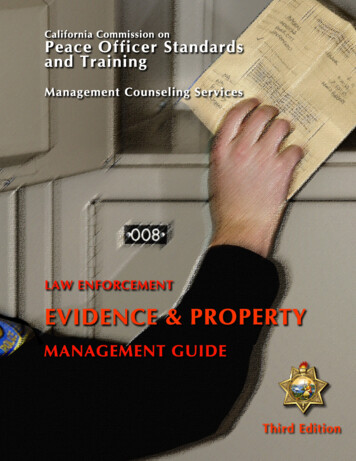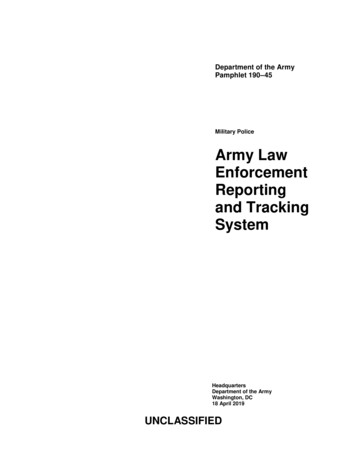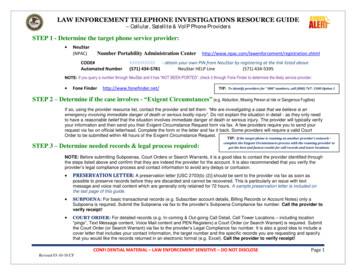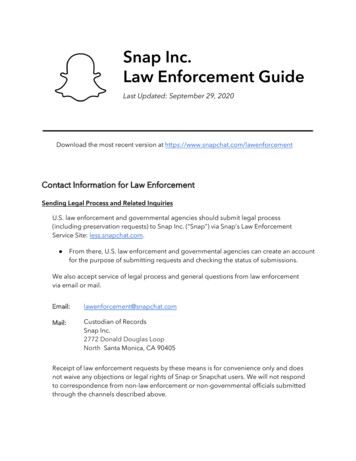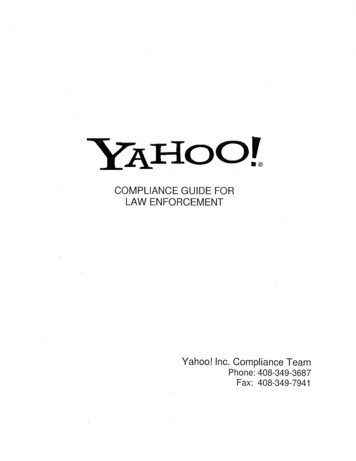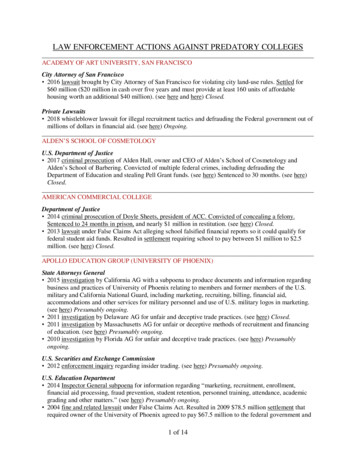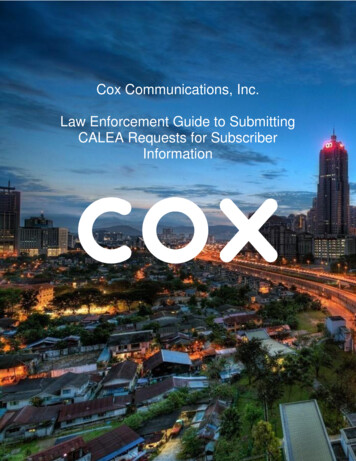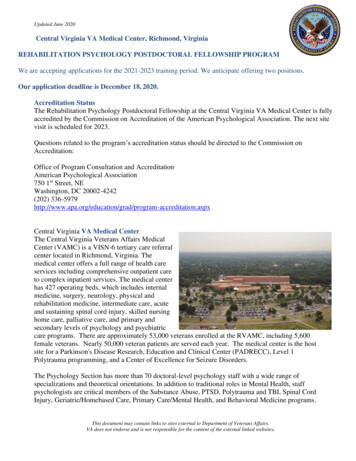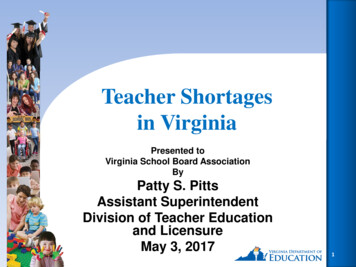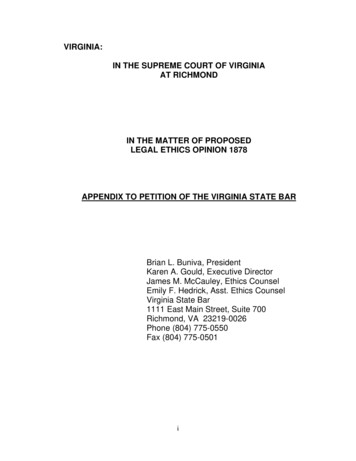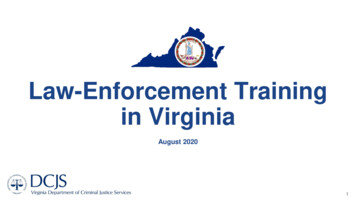
Transcription
Law-Enforcement Trainingin VirginiaAugust 20201
The Department of Criminal Justice ServicesDCJS is a multi-faceted agency, dedicated to improving and promoting publicsafety across the Commonwealth.There are several divisions within the agency, each responsible for carryingout a different aspect of this mission.2
3
DCJS Constituents & Stakeholders Law Enforcement AgenciesLaw Enforcement Training AcademiesCommonwealth’s AttorneysLocal Government OfficialsPrivate Security BusinessesPrivate Security RegistrantsPrivate Security Training SchoolsBB/BEASpecial Conservators of the Peace(SCOPS)LocksmithsTow Truck DriversCJSB/PSSABNon-profit OrganizationsCourts – juvenile, circuit, generaldistrictLocal ProbationState Probation Public School PersonnelState AgenciesFederal AgenciesVirginia State Crime CommissionVirginia Association of Campus LawEnforcement AdministratorsVirginia Law Enforcement ProfessionalStandards CommissionVirginia Law Enforcement AccreditationCoalitionCrime Prevention Training AdvisoryCommitteeLaw Enforcement Command AdvisoryGroupVirginia Association of Directors ofCriminal Justice TrainingVirginia Crime Prevention Association International Association of Chiefs ofPolice Supreme Court of Virginia Community Corrections Treatment Agencies CIT Programs Victim Agencies Children/Juvenile Programs Trainings and People Trained Sexual Assault Victims Domestic Violence Victims Campus Security Officers School Resource Officers Private and Public Institutions ofHigher Education4
Division of Programs and ServicesThe Division provides assistance to Adults, Juveniles, and Victims.These services include: Probation and Pretrial training and standardsJail Mental Health programsPost Incarceration Re-entry programsResidential Substance Abuse TreatmentJuvenile Justice and Delinquency PreventionChild Welfare/Court Appointed Special Advocate ProgramEmergency Crisis ResponseTrainingGrants Administration5
Virginia Center for School andCampus Safety (VCSCS)Through Virginia Code § 9.1-184, the VCSCS is mandated to: Provide training for stakeholdersDevelop and disseminate resources to improve school safetyFacilitate the annual school safety audit pursuant to § 22.1-279.8Provide technical assistance for Virginia School DivisionsDevelop partnerships to promote school safety and campus in Virginia6
Division of Licensure and Regulatory ServicesThe Division provides oversight and enforcement of five statutory orregulatory programs serving the private side of public safety. Private Security Services (security officers; private investigators; armored carpersonnel; electronic security technicians, sales representatives, dispatchers; personalprotection specialists; locksmiths, etc.) Bail Bondsmen (property, surety and agent) Bail Enforcement Agents Special Conservator of the Peace Tow Truck Drivers7
Division of Law EnforcementThe Division is responsible for regulating criminal justice professionalsand criminal justice training academies across the Commonwealth.This includes: Facilitating revisions to training standards Tracking mandated training Certifying and de-certifying law-enforcement officers and jail officers Academy and agency audits to ensure compliance Six Field Services Coordinators cover the state (3FTE; 3PTE) Virginia Law Enforcement Professional Standards Committee accreditation Developing model policies8
Law-Enforcement Agencies Regulated by DCJSCity/County Sheriff’s Offices123Police Departments174Campus Police Departments41State Law-Enforcement Agencies12Private/Airport/Railroad20Criminal Justice Training Academies39LE Communications Centers43Regional Jails/Detention Centers24TOTAL Agencies4769
Officers Regulated by DCJSLaw-Enforcement OfficersJail OfficersCourt Security/Civil 176TOTAL41,05510
Training Standard StructureCriminal JusticeServices BoardCommittee on TrainingCurriculum ReviewCommitteeDCJSFacilitatesProcessSME’sJob Task Analysis11
Committee on Training MembershipVirginia Code § 9.1-112The Committee on Training (COT) is composed of 15 members of the Criminal Justice Services Board: The Superintendent of the Department of State Police The Director of the Department of Corrections The member of the Private Security Services Advisory Board The Executive Secretary of the Supreme Court of Virginia The two sheriffs representing the Virginia State Sheriffs Association The two representatives of the Virginia Chiefs of Police Association The active-duty law enforcement officer representing police and fraternal associations The attorney for the Commonwealth representing the Association of Commonwealth’s Attorneys The representative of the Virginia Municipal League The representative of the Virginia Association of Counties The regional jail superintendent representing the Virginia Association of Regional Jails The citizen representing community interests One member designated by the chairman of the Board from among the other appointments made bythe Governor12
Curriculum Review Committee Membership6 VAC 20-20-10The Law Enforcement Curriculum Review Committee (CRC) consists of nineindividuals representing the certified criminal justice training academies,appointed by the Committee on Training (COT). Four members representing regional criminal justice training academies Four members representing independent criminal justice training academies One member representing the Department of State Police Training Academy13
Law-Enforcement Training in VirginiaCOTThe Committee onTraining (COT)approves thetraining standardsin Virginia.WHATWhat to teachACADEMYHOWEach academyis responsiblefor developingcurriculum andlesson plans tomeet thosestandards.How to teachMay go aboveand beyond theminimumstandards.14
Academy Structure in Virginia11 Regional Academies(serve 11,874 Law Enforcement Officers)Each Regional Academy: Serves multiple agencies, including police departments, sheriff’s offices, dispatch centers,and regional jails Provides mandated basic and in-service training as well as non-mandated training Receives funding from the state and from the member academies15
Academy Structure in Virginia28 Independent Academies(Including DCJS, serve 10,406 Law Enforcement Officers)Each Independent Academy: Serves only one agency Provides all mandated training for that agency as well as non-mandated training Is primarily self-funded16
Current AcademyLaw-Enforcement Officer PopulationIndependent10,406Regional11,87417
Regional Academy State Funding FY2020Cardinal 160,187Central Shenandoah 254,448Central Virginia 255,304Crater 201,691Hampton Roads 335,254New RiverNorthern VirginiaPiedmont 85,822 362,285 92,182Rappahannock 259,177Skyline 94, 587SouthwestTOTAL: 183,548 2,284,484 1,001,074 of this is state general funddollars, the rest generated by court feespaid into the Regional Criminal JusticeTraining Academies Fund.18
Academy Numbers by State with SimilarPopulationsVIRGINIA*Includes college/university programs19
VIRGINIAAcademy Numbers Nationwide*Some states combine the number of academies with those of college/university programs.Source: Per the Bureau of Justice Statistics, there are 664 academies across the country (2013).20
Basic TrainingMinimum Mandated HoursActual HoursBasic Training480 hours680–1500 hoursField Training100 hours100–800 hours21
In-Service TrainingLaw-Enforcement Officers are required to complete40 hours of in-service training every two years.General career development34 hoursLegal training4 hoursCultural diversity2 hoursTOTAL:40 hours22
Average Annual In-service Hoursand Mandates By StateStates that requirehours/mandatesStates with hourlyrequirements butno mandatesAverage: 18.1866 hrsMedian: 20 hrsVIRGINIAStates with norequirements23
National In-service Hours and MandatesStateAnnual Avg.HoursBreak y 3 years16/year38/2 year24/year60/3 year16/yearFlorida1040/4 yearGeorgiaHawaii20020/yearNoneIdaho2040/2 yearsIllinois0NoneIndiana2424/year2 firearms, 2 use of force, 2 drivingIowa1212/year1 hour mental health, firearms, CPRKansas4040/yearAny police-related topic, plus bias-based policingKentucky4040/yearNone specifiedLouisiana2020/year8 firearms, 4 officer survival, 2 legal, 6 electiveMaine2040/2 yearsInterpersonal communications, mental health awareness, ethics & professionalism, and officer/violator ContactN/AFirearms, emergency vehicle operations, pursuit, first aid, physical conditioning, and high risk stopsEthics, firearms, uof, defensive tactics, racial profiling, sexual harassment, PREA, CPR, and critical incident report writing4 arrest and control, 4 driver training, 4 tactical firearms, others depending on assignment/rank12 arrest control, driving, and firearmsMinimum of 3 hours firearms/yearly is recommended; others depending on assignmentAnnual firearms qualification, varied career-related training, and must also do CPR, AED, First Responder certificationFirearms qualification every 2 years plus human diversity, uof, domestic violence, discriminatory profiling and professionalTraffic stops, and juvenile sexual offender investigations trainingVaries but must include 1 hour firearms proficiency, 1 hour use of deadly force, and 2 hours community policingN/ANo specific number of hours required, but departments are required to train officers in civil rights, constitutional and properUse of law enforcement authority, cultural competency, human rights, law update, procedural justice or use of forceN/AVaries by cycle, 20 will be mandated, 20 elective (topics change yearly but include implicit bias and autism training); firearms &legal update constant24
National In-service Hours and MandatesStateAnnual Avg.HoursBreak downMaryland1818/yearFirearms qualification yearly; sexual abuse, treatment of victims of crime, victims’ services, and identity fraud victims’ rightsevery 3 years. CPR every 2 yearsMassachusetts4040/yearFirearms qualification and CPR every year; electives change yearlyMichigan0NoneMinnesota1648/3 yearsMississippi2424/yearMissouri1648/3 yearsMust include 1 hour racial profiling, 2 hours mental health, 2 hours officer well being, 2 hours implicit bias recognition, 2 hoursde-escalation, and 2 hours firearmsMontana1020/2 yearsVaries by department but must include a yearly review of police code of ethicsNebraska2020/yearNone specified/varies by departmentNevada1212/yearLegislative mandated topics including de-escalation, officer wellbeing, firearms, racial profiling, mental health, human trafficking,intrinsic biasNewHampshire1212/year4 fa/uof; 8 any topic plus first aid, CPR, and DT refreshersNew Jersey0VariesNew Mexico205.5/year, 40/2 yearsNew York0None unlessaccreditedNorth Carolina2424/yearFirearms proficiency required yearly; the state does set advisory training standards: officer safety, communication, emergencyvehicle operations, defensive tactics, legal update and mental disordersUse of force yearly, driving every 5 five yearsNone/varies by departmentFA, UoF, Pursuit, Domestic Violence mandated for all, remainder varies based on assignment/departmentDV (1), child safety (1), child abuse (1), and pursuit training required21/year if accredited; all officers must receive annual instruction in deadly physical force and the use of firearms and otherweaponsLegislative mandates that can change yearly25
National In-service Hours and MandatesStateAnnual Avg.HoursBreak downNorth Dakota2060/3 yearsOhio2424/yearVarying topics including community-police relations and crisis de-escalationOklahoma2525/yearAnnual firearms qualification and at least 2 hours de-escalation trainingOregon2884/3 yearsPennsylvania1212/yearRhode Island0NoneSouth Carolina13.3340/3 yearLegal update and domestic violence/yearlySouth Dakota2040/2 yearsFirearms and varying other topicsTennessee4040/yearTexas2040/2 yearsUtah4040/yearNone specified/varies by departmentVermont3030/yearFirearms, CPR, domestic violenceVirginia2040/2 yearsWashington2424/year2 de-escalation, none others specifiedWest Virginia1616/yearFirearms plus varying topicsWisconsin2424/yearHandgun proficiency yearly; pursuit every other yearWyoming2040/2 yearsFirearms plus varying topics (that may be online only)8 firearms/use of force/year; 1 ethics/year; 3 mental health/CIT/year plus CPR; others as appropriate based on assignment/rankannual firearms qualification, CPR and first aid, legal updatesHate crimes, gangs, and domestic violence training required by statute that may change yearlyChild sexual abuse, emergency vehicle operation and 8 hours of firearms proficiencyDe-escalation required yearly but no set hours; legal update, cultural diversity, and special investigative topics; additional trainingrequirements for "intermediate peace officer" recertification34 career-related, 4 legal, 2 cultural diversity; annual firearms qualificationRequirement varies based on tenure as officer, required topics may vary based on assignment26
Current Review Process In 2017, DCJS began the process of updating the Compulsory Minimum TrainingStandards for Entry Level Law-Enforcement Officers pursuant to a requirement inthe state budget.“The Director and the Board shall ensure that the training standards appropriatelyeducate law-enforcement officers in the areas of mental health, community policing, andserving individuals who are disabled. The updated compulsory minimum trainingstandards shall, where appropriate, include consideration of, but not be limited to, therecommendations of the President’s Task Force on 21st Century Policing. The Directorshall identify current resources available to officers in dealing with situations related tomental health and identify what resources are needed.” Review began with a contractor driven Job Task Analysis (JTA), which was asurvey of over 1,500 law enforcement officers across the Commonwealth todetermine the tasks deemed essential for a new officer.27
Current ReviewDCJS staff has facilitated meetings with SMEs and the CRC to revise currentstandards, remove unnecessary standards, and create new standards,using the JTA and 21st Century Task Force Report as guide posts.Draft revised standards in the areas of de-escalation,bias-based policing, and responding to personsin crisis have seen significant enhancement.Draft revised standards include recommendationsfor additional content on active attackresponse training and officer wellness.28
Training Standards Revision PresentationsSeptember 2020 – March 2021 DCJS and the CRC will meet with the public and law-enforcementagencies to present and discuss the proposed revisions. Meetings will take place regionally, in an effort to provideopportunities for extensive feedback. After these meetings, additional revisionswill likely occur.29
Approval Process Notice of proposed revisions and an opportunity for public comment areposted on the Virginia Regulatory Town Hall for a minimum of 60 days. After these series of meetings and reviews, the training standards arepresented to the COT for review and approval.30
Committee on Training ReviewThe CRC will present the proposed revisions to the COT.Public comment is available during the COT meeting. TheCOT can vote in the following manner during the meeting:Reject all proposed languageand decide no revisions arenecessary.Accept all proposedlanguage as submitted.Reject all proposedlanguage and ask foradditional work.Accept proposed languagewith additional revisionsmade during the meeting.31
Summary of ProcessReviewDocuments/JTACRC Reviewand ApprovalConvene CRCand SMEgroupsPost to VirginiaTown Hall andpublic presentationsfor PublicComment/ReviewSMEs DraftlanguageAcademy/Additional SMEreview andcommentReview PublicComment,revisions asneededPresent to COTfor final publiccomment andapproval32
Current Training Standards CategoriesThere are currently eight mandatory categories of training.ProfessionalismLegal IssuesCommunicationPatrolInvestigationsDefensive TacticsUse of ForceDriver TrainingWeapons
Draft RevisedTraining StandardsProfessionalism Police Ethics Bias-Based Policing Duty to interveneInvestigations Legal Issues DefensiveTacticsUse of Force Communication Interacting with personsin crisisDriver Training Patrol Weapons OfficerWellness
Structure of Training StandardsA training standard is broken down into several components:PerformanceOutcome (PO)TrainingObjectiveCriteriaLesson PlanGuideThis is theknowledge or skillthat the recruitmust learnHow the recruitshould showknowledge of theperformanceoutcomeItems coveredduring training onwhich the recruitwill be testedElements thatshould be in thelesson plan toensure therequired criteriaare covered
Hiring Officers in Virginia Agencies are required to do background investigations on prospective officers. Statute only specifies a fingerprint-based criminal history records check forpurposes of the background investigation. Information regarding past performance/termination is not often easilydiscovered or shared. Hiring agencies cannot access a potential officer’s training recordswithout the officer’s express consent. Chiefs, Sheriffs, and DCJS have civil immunity for good faith disclosure ofinformation (Va. Code Section 15.2-1709).36
Decertification in VirginiaOfficers are subject to decertification in the following circumstances:Conviction of or guilty/no-contest plea to a:FelonyFailure to comply with trainingrequirementsConviction of or guilty/no-contest plea to a:Misdemeanor of moral turpitudeMisdemeanor sex offenseRefusal to submit to a drug screen orProviding a positive drug screenMisdemeanor domestic assaultThere are no statutory grounds to decertify an officer based on ethical concerns, policyviolations, Brady violations, non-criminal excessive force, or general misconduct.37
Decertifications in VirginiaYearNumber of DecertificationsType of Qualifying EventsFelony (4)20158Misdemeanor of moral turpitude (3)Misdemeanor sex offense (1)2016720177Felony (7)Felony (5)Misdemeanor of moral turpitude (2)Felony (5)Misdemeanor of moral turpitude (3)201815Positive drug screen (3)Misdemeanor sex offense (2)Misdemeanor domestic assault (2)Felony (4)20196Misdemeanor of moral turpitude (1)Misdemeanor domestic assault (1)20201Felony38
Decertification ProcessAgency notifies DCJSof triggering eventVA Code does notauthorize decertification foractive officers unlesschief/sheriff/commonwealthattorney notifies DCJS inwriting within 48 hours of atriggering event.DCJS decertifiesofficer, notifies officerof decertification andright to appealIf no appeal,decertification final,may petition forreinstatement in 5 yearsAppeal heard by theCriminal JusticeServices BoardOfficer is entered intoNational DecertificationIndexDecertificationoverturned, OfficerReinstatedDecertification upheld,may petition forreinstatement in 5 years39
Termination vs. Decertification in Virginia Termination or resignation does not mean decertification. Termination information is uploaded into the DCJS database byemploying agencies. DCJS is not privy to cause(s) for separation/termination. There is no other centralized database for officers who have beenterminated for cause but not decertified.40
National DecertificationsVirginia is a participant in the voluntary National Decertification Index (NDI),a national registry of certificate or license revocation actions maintained bythe International Association of Directors of Law Enforcement Training(IADLEST).When a decertification is finalized, DCJS staff enters the former officer in thesecure NDI database.Over 150 state or local agencies in Virginia have access to NDI.41
Questions?Shannon DionDirectorshannon.dion@dcjs.virginia.gov(804) 786-8718Megan PetersonChief Deputy Directormegan.peterson@dcjs.virginia.g
Each Regional Academy: Serves multiple agencies, including police departments, sheriff’s offices, dispatch centers, and regional jails Provides mandated basic and in-service training as well as non-mandated training Receives funding from the state and from the member academies 11 Regional Academies (serve 11,874 Law Enforcement Officers)
